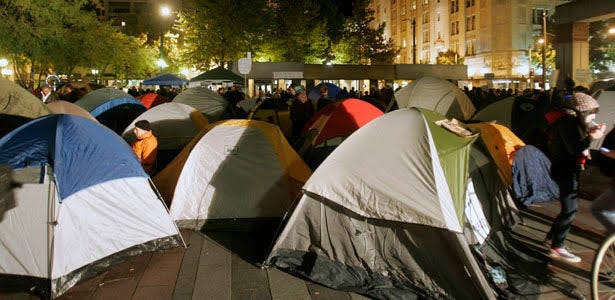WHAT IF?
What if nobody went home? What if, after the chants died down and the frogs deflated, we didn’t shuffle back to our cars and timelines like obedient citizens clocking out of democracy? What if we just... stayed? Ordered pizzas. Rolled out sleeping bags. Turned the Capitol lawn into a campsite and said: “We’ll leave when you remember who you work for.”
Imagine the scene: a sea of tents, green vinyl frogs swaying in the night breeze, the smell of cold pizza and warm rebellion. Someone’s playing a guitar, someone else is painting a sign under a streetlight that says JOY IS RESISTANCE. The cameras return in the morning expecting silence — but find coffee, conversation, and a thousand people still there. Democracy, it turns out, snores.
But here’s where idealism collides with ordinance: camping on government property is illegal. Not “maybe” illegal — actually illegal. Federal grounds like the Capitol, White House, and National Mall prohibit overnight camping, sleeping, or setting up tents without a permit. Violate that, and you’re looking at fines ranging from $50 to $500 for local offenses, or up to $5,000 and 30 days in jail under federal code. States and cities have their own versions, complete with cheerful language about “unlawful occupancy” and “public right-of-way obstructions.” Translation: they can — and often will — clear you out after dark.
Still, history doesn’t move because everyone followed the rules. It moves when people decide that obeying a bad law is worse than breaking it. Civil disobedience isn’t chaos — it’s courage with a legal disclaimer. When people camped at Zuccotti Park during Occupy Wall Street, they weren’t there for the scenery. They were there to remind the powerful that “go home” isn’t a command — it’s a test.
So if you do stay, do it with your eyes open and your ducks (or frogs) in a row. Have legal observers on-site. Have medics. Know your rights. Set up a bail fund and a hotline number sharpied on every arm. Coordinate with the ACLU, not your group chat. Civil disobedience has moral gravity when it’s nonviolent, public, and prepared. The difference between a movement and a mess is logistics.
If this movement camps for democracy, let it do so with the same precision as a military operation — just one powered by compassion instead of conquest. Bring food, water, sanitation, first aid, and solidarity. Bring art. Bring warmth. Make the act of staying not just an act of defiance, but of creation — a living demonstration of the kind of world we want to build.
And yes, the cops may fine you, maybe even arrest you. But the fines are temporary. The statement is permanent. The sight of peaceful citizens refusing to leave the people’s lawn because they believe democracy is worth a few sleepless nights — that’s the kind of image that cracks history open.
So what if nobody went home? What if the revolution looked less like a riot and more like a campground? What if democracy didn’t just get defended — it got lived? Pack your tents, your tarps, and your thermoses. Bring your courage, your consent forms, and your sense of humor. Because one day, when our grandchildren ask what democracy looked like when it was on the brink, the right answer might be:
“It looked like a frog in a tent, refusing to leave.” 🐸
Closer to the Edge runs on caffeine, chaos, and reader support — no kings, no corporate sponsors, just truth and a few frogs with Wi-Fi. Subscribe to keep the lights on, the stories honest, and the pizza fund stocked for the next stand for democracy. 🐸





This is how they did it in Nepal. And, other places. We can’t just protest from 9-11am. And, I bet we could get people to donate food & water - like Jose Andres (love him). Ideas?
This is a great idea and it would definitely make a statement which desperately needs to be made. People should pack lunches and bring water - and be sure to take the trash with them when they do leave. No messes left for others to clean up, please.